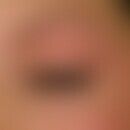Synonym(s)
DefinitionThis section has been translated automatically.
Flagellant dermatitis (from the Latin flagellum 'whip, scourge') refers to streaky or flat, pigmented, itchy, inflammatory skin changes that have been described after chemotherapy of tumor patients with bleomycin, more rarely after cyclophosphamide or fluorouracil. The skin changes occur in predisposed persons in the sense of a dose-dependent toxic effect, they are reproducible and substance-specific.
See also shiitake dermatitis.
EtiopathogenesisThis section has been translated automatically.
You might also be interested in
ClinicThis section has been translated automatically.
HistologyThis section has been translated automatically.
Hyperpigmentation of the basal epithelial layer with marked pigment incontinence, wall-thickened blood vessels with irregularly contoured endothelial layer and markedly narrowed lumen, perivascular sparse round cell infiltrates.
Electron microscopy: Wall-thickened capillaries with narrow residual lumen, villus-like cytoplasmic extensions of the endothelium, onion-skin-like proliferating pericytes, in between fine granular, electron-dense material; abundant collagen fibrils, metabolically active melanocytes with abundant melanosomes.
TherapyThis section has been translated automatically.
After discontinuation of bleomycin, inflammatory changes disappear within a few weeks. However, the post-inflammatory pigmentation remains for months or years. Oral antihistamines against itching such as desloratadine (e.g. Aerius) 1-2 tablets/day. In the still florid state, short-term external glucocorticoids such as Betamethasone Lotio R030.
Remaining hyperpigmentation can be covered cosmetically if necessary ( camouflage), e.g. with Dermacolor.
LiteratureThis section has been translated automatically.
- Albig J et al (1992) Flagellate hyperpigmentation by bleomycin. dermatologist 43: 376-379
- Altmeyer P et al (1984) A contribution to the pathogenesis of cutaneous bleomycin side effects. Act Dermatol 10: 191-196
- Duhra P et al (1991) Bleomycin-induced flagellate erythema. Clin Exp Dermatol 16: 216-217
- Nayak N et al (2003) Case 2 Bleomycin-induced flagellate dermatosis. Clin Exp Dermatol 28: 105-106
Incoming links (10)
Betamethasone valerate emulsion hydrophilic 0,025/0,05 or 0,1 % (nrf 11.47.); Bleomycin; Bleomycin hyperpigmentation; Cytostatically effective antibiotics; Hyperpigmentation, flagellate; Koebner phenomenon; Melanocyte; Non-allergic hematogenic contact dermatitis; Shiitake dermatitis; Spot darker;Outgoing links (17)
Antihistamines, systemic; Betamethasone; Betamethasone valerate emulsion hydrophilic 0,025/0,05 or 0,1 % (nrf 11.47.); Bleomycin; Camouflage; Chemotherapeutics; Cyclophosphamide; Desloratadine; Endothelium; Exanthema, urticarial; ... Show allDisclaimer
Please ask your physician for a reliable diagnosis. This website is only meant as a reference.







